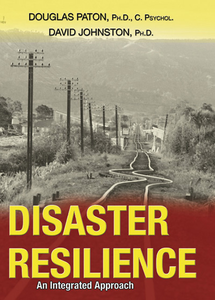Planning for hazard resilient communities
King, David (2006) Planning for hazard resilient communities. In: Paton, Douglas, and Johnston, David, (eds.) Disaster Resilience: an integrated approach. Charles C Thomas , Springfield, Illinois, USA, pp. 288-304.
|
PDF (Published Version)
Restricted to Repository staff only |
||
![[img]](https://researchonline.jcu.edu.au/3598/2.hassmallThumbnailVersion/3598_King_2006.jpg)
|
Image (JPEG) (Cover Image)
Download (132kB) |
Abstract
[Extract] The United Nations designated the 1990s as the International Decade for Natural Disaster Reduction (IDNDR). This drove a shift towards an emphasis on mitigation-awareness and preparedness. The aim was to identify vulnerability and to reduce it. During the International decade this shifted to a preference to identify and enhance strengths, specifically resilience. The outcome was the strategy of building hazard resilient communities. Despite IDNDR, loss of life and economic costs from natural hazards have continued to increase. Mitigation has been pushed by both political and economic necessities.
A response in Australia was to identify and quantify economic costs (BRS, 2001), followed by the Council of Australian Governments (COAG, 2002) review, a high-level review to establish mitigation priorities. The COAG review requires mitigation at all levels of government, and puts responsibility on planners as well as requiring an enhancement of resilience through civil responsibility, education and warnings. "Take action to ensure more effective statutory State, Territory and local government land use planning, development and building control regimes that systematically identify natural hazards and include measures to reduce the risk of damage from these natural hazards." "Reduce the problem of public infrastructure repeatedly damaged by natural disasters through cost-effective mitigation measures to make infrastructure more resilient. ... " "Develop jointly improved national practices in community awareness, education and warnings .... " The review goes on to identify specific actions. (COAG 2002 p. 4). The emphasis is on strengthening communities through awareness, education and warnings in order to enhance mitigation, and placing responsibility on Local Government Councils and land use planners.
| Item ID: | 3598 |
|---|---|
| Item Type: | Book Chapter (Research - B1) |
| ISBN: | 978-0-398-07663-4 |
| Keywords: | resilience; planning; hazard |
| Related URLs: | |
| Additional Information: | This publication does not have an abstract. The introduction is displayed as the abstract. |
| Date Deposited: | 17 Nov 2009 03:19 |
| FoR Codes: | 12 BUILT ENVIRONMENT AND DESIGN > 1205 Urban and Regional Planning > 120599 Urban and Regional Planning not elsewhere classified @ 50% 16 STUDIES IN HUMAN SOCIETY > 1605 Policy and Administration > 160513 Tourism Policy @ 50% |
| SEO Codes: | 90 COMMERCIAL SERVICES AND TOURISM > 9003 Tourism > 900303 Tourism Infrastructure Development @ 40% 96 ENVIRONMENT > 9699 Other Environment > 969999 Environment not elsewhere classified @ 30% 96 ENVIRONMENT > 9609 Land and Water Management > 960999 Land and Water Management of Environments not elsewhere classified @ 30% |
| Downloads: |
Total: 87 Last 12 Months: 6 |
| More Statistics |



